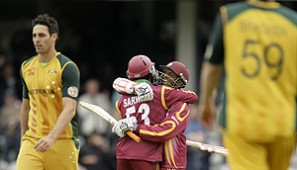The possibiliy of Jofra Archer's career coming to an early end will rob cricket of a bowler with so much talent
While a premature retirement isn’t the solution, he or England want, he may be forced into it if he can’t maintain a long run of matches.

Shivnarine Chanderpaul recently earned the distinction of becoming the second West Indian and the 10th batsman overall to score over 10,000 Test runs.
Also, and not for the first time, he was listed as the number one ranked Test batsman in the world. Both honors are richly deserved for he has been a great, if underrated, player.
For most of his 18-year career he has been the West Indies’ most adhesive batsman, at times the most adhesive in the game.
And in the storied history of West Indies cricket, perhaps only George Headley and Brian Lara were called upon to bear a greater burden than Chanderpaul is now carrying.
It has been so for a while.
The brittleness of the West Indies batting over the past decade or more has meant that a collapse is hardly ever a distant memory.
Rather, it is often hovering over the horizon, like a dark cloud threatening a thunderstorm.
The storm was sometimes averted.
And often, the man who stood between humiliation and respectability for the West Indies was the obdurate Guyanese: prodding, tapping, deflecting, edging even, but batting—usually for a very long time.
No full-throated flamboyance from him.
That is left to his more flashy teammates, like the incomparable Brian Lara in the past, and his present day clone and cousin, Darren Bravo.
Chanderpaul simply digs in and bats. Even when all is crumbling about him he remains resolute, warding off the storm.
He once batted 25 hours and 13 minutes over 4 innings and scoring 362 runs without losing his wicket. How India must have hated the sight of him coming to the crease in that series!
And don’t think he can’t be aggressive too. When the mood takes him, or when the situation requires it, he can score as quickly as anybody.
His 69 ball hundred against Australia on his home ground at Bourda in 2002 is fourth on the list of fastest Test hundreds, while his memorable 1996 assault on Shane Warne in Sydney was only interrupted by what Warne regarded as probably the best ball of his career.
But that was not really his game. He was the immovable one, the fighter, the tiger; batting as if his children’s lives depended on him remaining at the wicket.
During his recent 91 against Australia in the second Test he struck three fours off the first four deliveries (one of them a no-ball) of a James Pattinson over.
Before facing the next ball he retook his guard, as if reminding himself that his was a vital innings on a difficult surface and so he should return to his familiar cussedness and eschew alluring stroke play and its concomitant risks.
There is a myth that the lefthander is the more elegant of the specie.
Well, there is hardly anything elegant about Chanderpaul. Not that he cares; crabby is a word often used to describe his methods. And how effective those methods have been: watching the ball closely, playing unbelievably late, and ignoring anything not threatening his stumps. He has mastered the science of survival.
Chanderpaul is now in his thirty eighth year and so the day cannot be far off when he will leave the crease for the last time. I can imagine he would not be looking forward to that day for the crease has been like a second home; probably even a first, because a travelling cricketer is never in one place for very long.
The crease is probably where he is most comfortable, where he is most at-home.
The West Indies’ batting will probably continue to lack consistency after he decides to hang up his helmet. That would be a shame, for they had in their midst for a very long time a man who is among the most reliable to have donned the maroon cap.
Their inability to appreciate his value and grasp his ways cannot be laid at his feet—he can’t hold their hands forever.
So, for the short time that he has left with them, they would do well to sit and learn at the feet of the master.